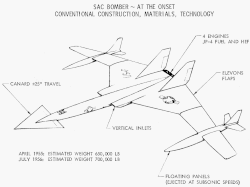North American XB-70 Valkyrie
| Den här artikeln behöver källhänvisningar för att kunna verifieras. (2025-02) Åtgärda genom att lägga till pålitliga källor (gärna som fotnoter). Uppgifter utan källhänvisning kan ifrågasättas och tas bort utan att det behöver diskuteras på diskussionssidan. |
| XB-70 Valkyrie | |
 NASA XB-70 1968. | |
| Beskrivning | |
|---|---|
| Typ | Bombflygplan |
| Besättning | 2 st |
| Första flygning | 21 september 1964 |
| Ursprung | |
| Tillverkare | North American Aviation |
| Antal tillverkade | 2 st |
| Data | |
| Längd | 56,6 meter |
| Spännvidd | 32 meter |
| Höjd | 9,4 meter |
| Vingyta | 585 m² |
| Vingprofil | Hexagonal; 0.30 Hex modified root, 0.70 Hex modified tip |
| Tomvikt | 93 000 kg |
| Max. startvikt | 250 000 kg |
| Motor(er) | 6 × General Electric YJ93-GE-3 |
| Dragkraft | 6 × 84,5 kN 6 × 128 kN (med EBK) |
| Prestanda | |
| Max. hastighet | Mach 3,1 |
| Räckvidd med max. bränsle | 6 900 km |
| Max. flyghöjd | 23 600 meter |
| Dragkraft/vikt: | 0,314 |
| Vingbelastning | 414,7 kg/m² |
| Ritning | |
 Ritning av North American XB-70 Valkyrie | |
North American XB-70 Valkyrie var ett bombflygplan som utvecklades för det amerikanska försvaret. Den tekniska utvecklingen av både luftvärnsrobotar och interkontinentala ballistiska robotar gjorde dock flygplanstypen överflödig och projektet lades med tiden ner.
Man byggde två prototyper av flygplanet. En tredje prototyp började byggas men slutfördes aldrig
Den 8 juni 1966 var den andra prototypen inblandad i en kollision och kraschade. Två personer omkom.
Museum
Det enda kvarvarande exemplaret kan beskådas på National Museum of the United States Air Force i Dayton, Ohio.
Galleri
- North American XB-70A Valkyrie på Wright-Patterson AFB flygmuseum.
- XB-70A Valkyrie i en start i augusti 1965.
- XB-70A på Edwards Air Force Base 1967.
- XB-70A första flygningen i september 1964.
- Cockpit.
- Första skissen till XB-70 från 50-talet.
- XB-70.
Se även
Externa länkar
Media som används på denna webbplats
Författare/Upphovsman: Tkgd2007, Licens: CC BY-SA 3.0
A new incarnation of Image:Question_book-3.svg, which was uploaded by user AzaToth. This file is available on the English version of Wikipedia under the filename en:Image:Question book-new.svg
North American Aircraft's original proposal for WS-110A, which would eventually lead to the B-70. From NASA CR-115703, Volume 2, page 22.
NAA's final proposal for WS-110A, which would become the B-70. "BLC" refers to "boundary layer control", suction used to smooth the airflow in the engine intakes.
XB-70A parked on a ramp at Edwards Air Force Base in 1967.
Originally designed as a Mach 3 bomber, the XB-70A never went into production and instead was used for flight research involving the Air Force and NASA's Flight Research Center FRC, which was a predecessor of today's NASA Dryden Flight Research Center.
The aircraft's shadow indicates its unusual planform. This featured two canards behind the cockpit, followed by a large, triangular delta wing. The outboard portions of the wing were hinged so they could be folded down for improved high-speed stability.Författare/Upphovsman: KLaRock, Licens: CC BY-SA 4.0
An overhead view of the fourth building aircraft at the National Museum of the United States Air Force to include the North American XB-70 Valkyrie. The fourth building includes more than 70 aircraft in four new galleries -- Presidential, Research & Development, Space and Global Reach. (U.S. Air Force photo by Ken LaRock)Public Domain
North American XB-70A Valkyrie on the taxiway with a cherry picker. Photo taken Sept. 21, 1964, the day of the first flight. Note: the left main landing gear brakes locked during the landing causing two tires to blow. (U.S. Air Force photo)
A 3-view line drawing of the North American B-70 Valkyrie.
The #1 XB-70A (62-0001) is viewed from above in cruise configuration with the wing tips drooped for improved controllability. The XB-70A, capable of flying three times the speed of sound, was the world's largest experimental aircraft in the 1960s. Two XB-70A aircraft were built. Ship #1 was flown by the NASA Flight Research Center, Edwards, CA, in a high-speed flight research program.
Viewed from the front the #1 XB-70A (62-0001) is shown climbing out during take-off. Most flights were scheduled during the morning hours to take advantage of the cooler ambient air temperatures for improved propulsion efficiencies. The wing tips are extended straight out to provide a maximum lifting wing surface. The XB-70A, capable of flying three times the speed of sound, was the world's largest experimental aircraft in the 1960s. Two XB-70A aircraft were built. Ship #1 was flown by NASA in a high speed flight research program.
















